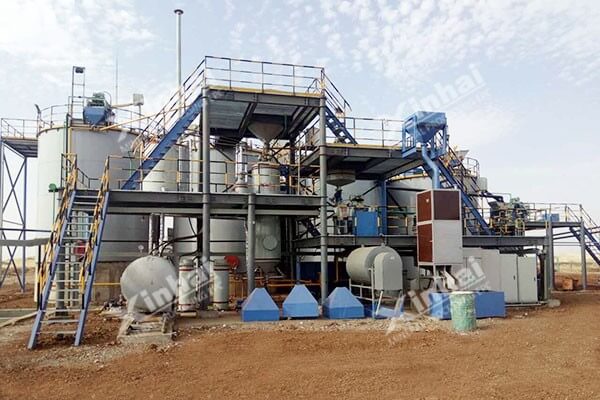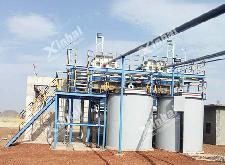

Warm Tip: If you want to know more details about equipment, solutions, etc, please click the button below for free consultation, or leave your requirements!

Since the gold rush in the 1970s, gold mining has been popular all the time. With the depletion of easily separated gold resources, the modern gold extraction equipment and technology is developing towards the extraction of gold from refractory gold deposits. At present, the most commonly used gold extraction method is gold cyanidation. More than 80% of the gold mines use gold cyanidation method to extract gold. What are the methods for gold cyanidation? What's the difference among these methods? What kind of ore can be gold cyanidation used in ?
Now let’s take a look at the commonly used gold cyanidation methods.
Commonly used gold cyanidation methods include carbon in pulp (CIP), carbon in leaching (CIL), pool leaching and heap leaching. Though there is only one word difference literally between them, there are huge differences in the actual process.
The pool leaching method is more suitable for ore that has a certain degree of oxidation and requires a longer leaching time. It can also be used in some gold mines that’s small-scale but not suitable for the construction of a whole dressing plant. In the gold ore dressing plant, these two methods can be used to separate tailings and recover gold from tailings to increase recovery rate.
The main difference between the carbon in pulp method and the carbon in leaching method is the order of leaching and adsorption. The carbon in pulp method can also be called all-sliming cyanidation. It is a method in which activated carbon is put into cyanidation pulp to adsorb the dissolved gold onto the activated carbon, and then the gold is extracted from the activated carbon. The carbon in leaching method is developed on the basis of the carbon in pulp method. On the basis of the carbon in pulp method, the adsorption and extraction processes are combined, and the mineral slurry is thickened before leaching, and the carbon is added shortly after the leaching, so that the leaching and adsorption are simultaneously performed, and then desorption electrolysis of gold-loaded carbon.
Compared with the two, the technology of the carbon in pulp method is relatively simple,and the equipment and the floor space of the carbon in leaching method are small. In addition, the carbon in leaching method is suitable for treating oxidized ore with a low sulfur content and a small amount of mud, and is not suitable for treating high silver content gold ore, the general ratio of gold to silver should not exceed 1:5; while the ore used in the carbon in pulp method is less harsh, usually suitable for ore with deep oxidation and no impurities such as copper, tin and carbon aceous materials. Since these two leaching methods involve the addition of activated carbon, the type of activated carbon also affects production efficiency, and the effects of activated carbon types are not considered here.
In summary, we can sort out the advantages and disadvantages of these four gold cyanidation methods as follows:
Cyanidation Methods | Heap leaching | Pool Leaching | CIP | CIL |
Application | Low grade gold and silver ore and tailings | Low grade gold and silver ore and tailings, low clay content | Ore with deep oxidation and no copper tin and carbonaceous material | Low sulfur content and high mud content Gold mine |
Recovery Rate | 65~80% | 50-70% | 90% or more | 90% or more |
Cost | lower | lower, slightly higher than heap leaching | higher | higher than CIP |
Advantages | The cost is relatively low, the low-grade gold mine has high recovery efficiency, the basic construction is simple | the cost is relatively low, and the low-grade gold mine with low economic benefits has improved effect, the staff cost is low | the technology is simple, the operation is convenient, and the activated carbon can be recycled | Leaching and adsorption at the same time, overcoming the shortcomings of the carbon slurry method, small equipment and footprint, and low capital investment |
Disadvantages | The land area is relatively large, the leaching time is longer, the ore property is stricter. | The leaching time is longer, the infrastructure such as the leaching pool needs to be built, the initial cost is higher. | The leaching and adsorption processes are separated, so the floor space and the infrastructure investment is large | The consumption of higher-loaded gold charcoal is more serious, and the amount of gold and silver lost with wear-loaded gold charcoal is higher. |
There are no two same mines in the world, and proper gold cyanidation methods varies from different ore conditions. Take a gold processing plant in Tanzania as an example, the gold ore in this mining area is mainly composed of sulfide ore and oxidized ore. After the dressing test, it is determined that all-sliming cyanidation method is the core. After the gold extraction process, the final oxidized gold leaching rate reached 93.75%, and the sulfide gold leaching rate reached 91.58%.
In order to recover useful minerals such as copper, gold and silver from tailings,a copper mine in Xinjiang, China decided to use a heap leaching method to treat tailings based on investment cost and process flow after multiple rounds of tests. From the oxidized ore, copper recovery rate reached 71.5%, gold recovery rate was 68.7%, silver recovery rate was 50.1%, copper recovery rate in sulfide ore was 30%, gold recovery rate was 78%, silver recovery rate was 50.1%, and metals in tailings were successfully recovered.
It turns out that even though there are so many common gold cyanidation methods, it’s better not to adopt any single method casually. Before determining the process,it is necessary to do a full beneficiation test to determine the appropriate gold cyanidation method according to the quality of different ores.
13 Common Questions about Gold Flotation Processing Technology
 2
2
 3368
3368
23 Methods for Extracting Gold from Leaching Solution in Cyanidation Plant
 0
0
 3652
3652


What Are the Differences Between CIP and CIL?
 10407
10407
 0
0